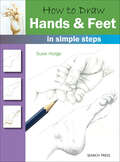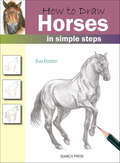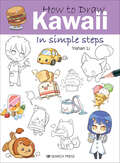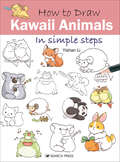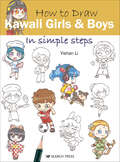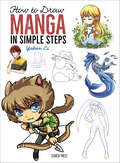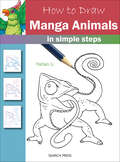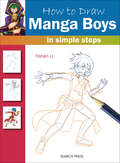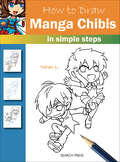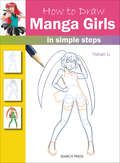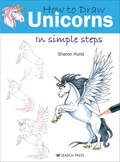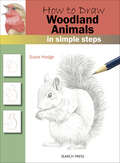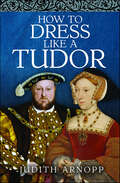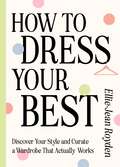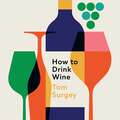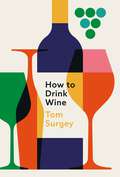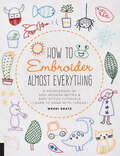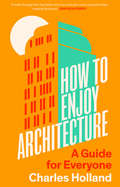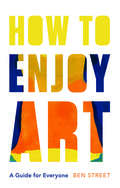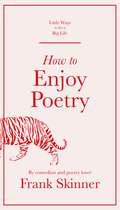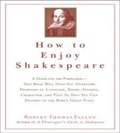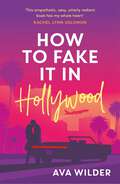- Table View
- List View
How to Draw: Hands & Feet
by Susie HodgeHands and feet are considered the hardest parts of the body to draw, due to the variety of shapes involved and their dynamism; and as a result they are often neglected by artists. In this book Susie Hodge, who has been teaching practical art for over 17 years, will demystify the process in creating these body parts and teach the reader how to draw them with simple illustrated instructions. In six stages Hodge builds up the shapes of the hands and feet to create a professional-looking sketch. Both beginners and the more advanced artists will benefit from this invaluable, easy-to-follow, step-by-step guide.
How to Draw: Horses
by Eva DuttonThis is a wonderful introduction to drawing horses and it really demystifies the process of building up the images from initial simple shapes right through to the finished animals. Eva Dutton breaks down the stages into easy steps using a two colour process that clearly shows every line and curve. Even absolute beginners will find themselves creating great drawings when they use this book. An invaluable guide for anyone interested in this subject.
How to Draw: Kawaii
by Yishan LiKawaii is a Japanese word meaning ‘super-cute’, and it’s a trend that’s sweeping the globe. Anything can be drawn in the kawaii style, from animals, people, vegetables and flowers to food, vehicles and household items. Here, expert comic book and manga artist Yishan Li shows you how to achieve amazingly adorable drawings in just a few simple steps. Draw the cutest rabbit you’ve ever seen, or turn a car into a cute and cuddly character complete with eyes and a smiley mouth. Even a vacuum cleaner and a television set are brought to life in kawaii style. There are 28 different drawings to choose from, all full of personality and bubbling over with charm. Each one is developed in 8 easy stages from a rough sketch of the basic shapes through to the finished, coloured drawing, making this book suitable for adults and children of all ages and abilities.
How to Draw: Kawaii Animals
by Yishan LiDraw adorable animals in eight simple steps with help from the popular comic book and manga artist. “There is much here to be learned from this expert.” —BooklistKawaii is a Japanese word meaning “super-cute,” and it’s a trend that’s sweeping the globe. Anything can be drawn in the kawaii style, from animals, people, vegetables and flowers to food, vehicles and household items. Here, expert comic book and manga artist Yishan Li shows you how to draw amazingly adorable animals in just a few simple steps. Draw the cutest rabbit you’ve ever seen, a playful panda, koala, fox, sheep and more. There are twenty-eight different drawings to choose from, all full of personality and bubbling over with charm. Each one is developed in eight easy stages from a rough sketch of the basic shapes through to the finished, colored drawing, making this book suitable for adults and children of all ages and abilities.
How to Draw: Kawaii Girls and Boys
by Yishan LiKawaii is a Japanese word meaning ‘super-cute’, and it’s a trend that’s sweeping the globe. Anything can be drawn in the kawaii style, from animals, people, vegetables and flowers to food, vehicles and household items. Here, expert comic book and manga artist Yishan Li shows you how to achieve amazingly adorable girls and boys from all walks of life in just a few simple steps - from waiters and doctors to princesses and fairies. There are 28 different drawings to choose from, all full of personality and bubbling over with charm. Each one is developed in 8 easy stages from a rough sketch of the basic shapes through to the finished, coloured drawing, making this book suitable for adults and children of all ages and abilities.
How to Draw: Manga
by Yishan LiIf you have always wanted to draw manga but weren’t sure how to begin, this fun and simple step-by-step book will help kick-start your comic-drawing journey. Learn how to draw boys, girls and creatures (ordinary and extraordinary) in the manga style. Starting with basic shapes, professional manga artist Yishan Li shows how easy it is to turn circles, rectangles, squares and ovals into teens, kids, witches, wizards, monsters, animals and much more. Professional manga art from well-known comic creator Yishan Li Over 130 step-by-step drawings Easy method with great results
How to Draw: Manga Animals
by Yishan LiAnimals are a popular subject within the manga genre, and this book is perfect for anyone seeking to learn the basics of creating these amazing creatures. The reader can choose from 28 different manga animals, all full of character and in a range of dynamic poses, including a dog, panda, fox, chameleon and penguin. Each drawing is developed in eight easy stages from a rough sketch of the basic shapes through to the finished, coloured drawing, making this book suitable for adults and children of all ages and abilities.
How to Draw: Manga Boys
by Yishan Li28 different characters, poses and expressions that offer a dynamic selection of Manga-style male figures.Drawing boys is a very popular subject within the manga genre and this book is perfect for anyone seeking to learn the basics of creating these delightful characters.
How to Draw: Manga Chibis
by Yishan Li28 different characters, poses and expressions that offer a dynamic selection of manga chibi figures. Chibis are a fun subject to explore, with large eyes, tiny bodies and very expressive emotions. This is a genre perfect for anyone seeking to learn a simpler form of manga and the basics of creating these delightful characters.
How to Draw: Manga Girls
by Yishan Li28 different characters, poses and expressions that offer a dynamic selection of Manga-style female figures. Drawing girls is a very popular subject within the manga genre and this book is perfect for anyone seeking to learn the basics of creating these delightful characters. Suitable for adults and children of all ages and abilities.
How to Draw: Unicorns
by Sharon HurstUnicorns have captured the imagination of people all over the world. These fantastical creatures have never been so popular, and well-known fantasy artist Sharon Hurst shows you how to bring them to life in this, her first book. Containing 26 different unicorns to draw in a range of poses and styles, each one is achieved in just 7 simple steps, making this book suitable for all ages and abilities. Each one starts with a few basic shapes and is developed into a finished tonal drawing, and a final coloured version shows you how to take your drawing even further. Choose from majestic winged creatures or playful young unicorns and discover how easily you too can create these amazing fantasy animals.
How to Draw: Woodland Animals
by Susie HodgeLearn how to draw all kinds of woodland animals using this fun and easy step-by-step method. Starting with simple shapes, Susie Hodge shows you how easy it is to develop circles, rectangles, squares and ovals into an exciting selection of animals and birds including rabbits, badgers, woodpeckers, wolves, squirrels and chipmunks. If you have never drawn before this is definitely the book for you, and there is a lot here to inspire more experienced artists too.
How to Dress Like a Tudor
by Judith ArnoppThe perfect how-to guide for dressing like your favorite Tudor. Have you ever hankered to dress like a Tudor lord or lady, or perhaps you prefer the status of goodwife, or costermonger, or even a bawd? For beginner historical reenactors, the path to authenticity can be bewildering and sometimes intimidating. Judith Arnopp uses her own experience, both as a historian and a medieval/Tudor lady, to make your own journey a little easier. The author traces the transition of fashion from the relatively subtle styles popular at the court of Henry VII, through the carefully constructed royal grandeur of Henry VIII, Edward VI, and Mary I to the pinnacle of majesty and splendid iconography of Elizabeth I. In contrast to the magnificence of court come the ordinary folk who, subject to sumptuary laws and regulations, wore garments of a simpler cut and cloth – a strata of society that formed the back bone of Tudor England. This brief history of sixteenth century fashion examines clothing for both rich and poor, adult and child, and offers tips and tricks on how to begin to sew your first historically inspired garment, this book is aimed at helping the beginner learn How to Dress like a Tudor.
How to Dress Your Best: Discover Your Personal Style and Curate a Wardrobe That Actually Works
by Ellie-Jean RoydenUnlock your full style potential. Transform your wardrobe. Dress your best.In How to Dress Your Best, TikTok's favourite fashion guru and style consultant Ellie-Jean Royden equips you with the tools and advice you need to curate a transformative wardrobe for everyday life.Ellie-Jean expertly guides you through the complicated work of dressing to your best colours and finding the silhouettes that make you shine. She teaches us that true style is not about dressing yourself to restrictive shapes or fruits, but about learning how to honour your natural line and dress in harmony with it. Best of all, Ellie-Jean breaks down her unique styling systems tested and loved by thousands of her clients, offering you the ultimate personal-styling experience. Packed full with interactive quizzes and inspirational mood boards throughout, this must-have guide will teach you how to ditch the cycle of trend buying and build a dream wardrobe that makes you look and feel amazing.
How to Dress Your Best: Discover Your Personal Style and Curate a Wardrobe That Actually Works
by Ellie-Jean RoydenUnlock your full style potential. Transform your wardrobe. Dress your best.In How to Dress Your Best, TikTok's favourite fashion guru and style consultant Ellie-Jean Royden equips you with the tools and advice you need to curate a transformative wardrobe for everyday life.Ellie-Jean expertly guides you through the complicated work of dressing to your best colours and finding the silhouettes that make you shine. She teaches us that true style is not about dressing yourself to restrictive shapes or fruits, but about learning how to honour your natural line and dress in harmony with it. Best of all, Ellie-Jean breaks down her unique styling systems tested and loved by thousands of her clients, offering you the ultimate personal-styling experience. Packed full with interactive quizzes and inspirational mood boards throughout, this must-have guide will teach you how to ditch the cycle of trend buying and build a dream wardrobe that makes you look and feel amazing.
How to Drink Wine
by Tom SurgeyFrom grape to glass, this highly readable and charismatic guide will teach you everything you need to know to enjoy wine.Wine is one of the most popular drinks across the globe, it brings people together and has a rich social and cultural history, it's also astoundingly delicious. But it can also be intimidating, confusing and unnecessarily complicated. It can be hard to know where to start: how is wine made? What's the difference between red and white? How do I know what to buy in a shop? Am I holding my glass correctly?In this modern and accessible introduction to wine, Tom Surgey answers all these questions and more; doing away with old-school snobbery and teaching you how to get the most out of your favourite drink.
How to Drink Wine
by Tom SurgeyFrom grape to glass, this highly readable and charismatic guide will teach you everything you need to know to enjoy wine.Wine is one of the most popular drinks across the globe, it brings people together and has a rich social and cultural history, it's also astoundingly delicious. But it can also be intimidating, confusing and unnecessarily complicated. It can be hard to know where to start: how is wine made? What's the difference between red and white? How do I know what to buy in a shop? Am I holding my glass correctly?In this modern and accessible introduction to wine, Tom Surgey answers all these questions and more; doing away with old-school snobbery and teaching you how to get the most out of your favourite drink.
How to Embroider Almost Everything: A Sourcebook of 500+ Modern Motifs & Easy Stitch Tutorials
by Wendi GratzThis embroidery sourcebook teaches you to turn a few basic stitches into endless creative designs—from alligators and bicycles to yucca plants and zebras.In How to Embroider Almost Everything embroidery designer Wendi Gratz shares more than five hundred inspiring, fun, and sophisticated stitch motifs that offers a fresh take on embroidery. Gratz offers fully illustrated instruction for each design, plus step-by-step tutorials in each of the easy stitch techniques you’ll need.You can re-create the motifs exactly as shown using the accompanying templates and stitch guides, or give them your own creative spin by changing details and colors to suit your own style.This giant reference volume includes:A detailed checklist of everything you’ll need to embark on your stitch journey: threads, needles, fabric, and more.Step-by-step tutorials for essential stitches and other techniques for creating the motifsAnswers to common questions and invaluable tips and tricks.500+ modern motifs for almost everything, including people and pets, trees and flowers, everyday objects, food, home, and more.Each book in the Almost Everything series offers a fun, comprehensive, and charmingly illustrated visual directory of ideas to inspire skill.
How to Enjoy Architecture: A Guide for Everyone
by Charles HollandCharles Holland challenges us to look beyond the day-to-day familiarity of buildings to rediscover the pleasure of experiencing architecture Architecture is bound up with our daily lives but, for most of us, it is experienced as a blur of habit. Our reactions towards the buildings that surround us are often culturally generated, and we experience them in ways that are immediate but often mundane. How to Enjoy Architecture: A Guide for Everyone encourages us to move beyond this and, instead, really look at buildings. Renowned architect Charles Holland talks about the buildings and architects that excite and inspire him, and the ideas and principles through which we can engage with architecture. By breaking buildings down into categories such as materials, structure, space, and use, Holland guides us through drastically different styles and building types—from the satisfying symmetry of a Queen Anne house to the thrill of a high-tech tower, or the social ideals that lie behind a housing estate. In doing so, he demonstrates how looking at, experiencing, and using architecture can bring joy in itself. "A book that will enrich any encounter with a building, it made me want to look harder and be more curious. We are led playfully through the fundamentals of architecture so that we might enjoy the details and the poetry of buildings all the more. A walk through the city feels more fun and also more profound after reading this book." Grayson Perry, artist "We so often encounter architecture when it goes wrong, or offends us with its looks. Holland, though, is the perfect, clear-headed tour guide to help us appreciate it with newly sharpened senses and fall in love again – even those buildings we think we hate." Tom Dyckhoff, academic and broadcaster "An enlightening and urbane exploration of architecture that resonates beyond conventional chronological histories" Catherine Slessor, architecture writer and critic
How to Enjoy Art: A Guide for Everyone
by Ben StreetAn entertaining and lively guide to rediscovering the pleasure in artHow to Enjoy Art: A Guide for Everyone provides the tools to understand and enjoy works of art. Debunking the pervasive idea that specialist knowledge is required to understand and appreciate art, instead How to Enjoy Art focuses on experience and pleasure, demonstrating how anyone can find value and enjoyment in art. Examples from around the world and throughout art history—from works by Fra Angelico and Berthe Morisot to Kazuo Shiraga and Kara Walker—are used to demonstrate how a handful of core strategies and skills can help enhance the experience of viewing art works. With these skills, anyone can encounter any work of art—regardless of media, artist or period—and find some resonance with their own experiences. How to Enjoy Art encourages us to rediscover the fundamental pleasure in viewing art.
How to Enjoy Poetry
by Frank Skinner'Someone recently said to me, in reference to my poetry podcast, that you'd think poetry would be more popular than ever, in the twenty-first century, because people don't have a lot of time and 'novels are often quite big while poems are often quite small'. I referred them to Doctor Who's Tardis.'Frank Skinner wants you to read more poetry. Wait, wait - don't stop reading. Whether you're a frequent poetry reader or haven't read any since sixth form, Frank's infectious passion for language, rhythm and metre will win you over and provide you with the basic tools you need to tackle any poem.In this short, easy-to-digest and delightful book, Frank guides us through the twists and turns of 'Pad, pad' by Stevie Smith, a short, seemingly simple poem that contains multitudes of meaning and a deceptive depth of emotion. Revel in the mastery of Stevie Smith's choice of words, consider the eternal mystery of the speaker of the poem and be moved by rhyming couplets like you never have before.Give it a go. You never know, you might even enjoy it.
How to Enjoy Poetry (Little Ways to Live a Big Life #12)
by Frank Skinner'Someone recently said to me, in reference to my poetry podcast, that you'd think poetry would be more popular than ever, in the twenty-first century, because people don't have a lot of time and 'novels are often quite big while poems are often quite small'. I referred them to Doctor Who's Tardis.'Frank Skinner wants you to read more poetry. Wait, wait - don't stop reading. Whether you're a frequent poetry reader or haven't read any since sixth form, Frank's infectious passion for language, rhythm and metre will win you over and provide you with the basic tools you need to tackle any poem.In this short, easy-to-digest and delightful book, Frank guides us through the twists and turns of 'Pad, pad' by Stevie Smith, a short, seemingly simple poem that contains multitudes of meaning and a deceptive depth of emotion. Revel in the mastery of Stevie Smith's choice of words, consider the eternal mystery of the speaker of the poem and be moved by rhyming couplets like you never have before.Give it a go. You never know, you might even enjoy it.
How to Enjoy Shakespeare
by Robert Thomas FallonIn How to Enjoy Shakespeare, the author explores Shakespeare's familiarity in five sections dealing with language, theme, staging, character, and plot, each abundantly illustrated with episodes and quotations from the plays.
How to Extend Your Victorian Terraced House
by Jacqueline GreenPacked with detailed plans and ideas for a range of house types and sizes, along with photos and 3D sketches, this book provides you with all the design inspiration and advice needed to embark on a Victorian terrace renovation. Case studies of various Victorian terrace house types reveal, floor by floor, a range of options for extending and/or rearranging the space, alongside practical guidance on ‘rules of thumb’ for design and information on permitted development rights. Colour-coded before-and-after plans show at a glance which walls have been removed or changed in each option, and all plans have been drawn to scale so that they may be measured from and used when planning your own home renovation project.
How to Fake it in Hollywood: A sensational fake-dating romance
by Ava Wilder'Besides the deliciously well executed fake-dating, How to Fake it in Hollywood delivers a raw, character-driven and heart-touching read. I absolutely loved it' ELENA ARMASA talented Hollywood starlet and a reclusive A-lister enter into a fake relationship . . . and discover that their feelings might be more than a PR stunt in this sexy chemistry-filled debut for fans of Beach Read and The Unhoneymooners.Early readers can't get enough!'Super fun, spicy and has a core of overwhelming love. The banter is amazing, characters are brilliant and the ending is EVERYTHING!! (I cried)' ⭐ ⭐ ⭐ ⭐ ⭐ reader review'I'm giving this book all of the stars. I can't believe that this is Ava Wilder's debut novel, it's really something' ⭐ ⭐ ⭐ ⭐ ⭐ reader review'Ava Wilder has a fantastic voice with just the right doses of humour and gravitas to get you onside with the characters' ⭐ ⭐ ⭐ ⭐ ⭐ reader review'A film-star worthy five-star read . . . it has everything you need, drama, passion, romance and some next level gut wrenching emotion wringing scenes . . . I simply adored this story' ⭐ ⭐ ⭐ ⭐ ⭐ reader review................................Grey Brooks is on a mission to save her career now that her long-running TV show is over. With the role of a lifetime on the line, she's desperate enough to agree to her publicist's scheme: fake a love affair with a disgraced Hollywood heartthrob, who just happens to also need the publicity boost. Ethan Atkins just wants to be left alone. Between his high-profile divorce, his struggles with drinking, and his grief over the death of his longtime creative partner and best friend, he's slowly let himself fade into the background. But if he ever wants to produce the last movie he and his partner wrote together, Ethan needs to clean up his reputation and step back into the spotlight. A juicy affair with a gorgeous actress might be just the ticket, even if it's the last thing he wants to do. With their plan working perfectly, the sizzling chemistry between Grey and Ethan soon starts to feel like more than just an act. But in this ruthless industry, are they both too used to faking it to open themselves up to the real thing?................................'This empathetic, sexy, utterly radiant book has my whole heart . . . How to Fake it in Hollywood is the real deal' RACHEL LYNN SOLOMON'The banter and sexual tension . . . is fire-emoji immaculate' LILLIE VALE'A fresh, witty, high-emotion story with compelling characters and stylish backdrops . . . The perfect novel for fans of modern, smart romance' SARAH HAYWOOD
